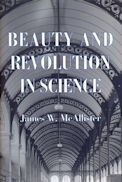P. A. M. Dirac explained why he embraced relativity by saying, “It is the essential beauty of the theory which I feel is the real reason for believing in it.” Dirac’s claim seems to belie rationalist accounts of science. Using this and a wealth of other historical examples, McAllister explains how scientists’ aesthetic preferences are influenced by the empirical track record of theories, describes the origin and development of aesthetic styles of theorizing, and reconsiders whether simplicity is an empirical or an aesthetic virtue of theories.
McAllister then advances an innovative model of scientific revolutions, in opposition to that of Thomas S. Kuhn. Three detailed studies demonstrate the interconnection of empirical performance, beauty, and revolution. One examines the impact of new construction materials on the history of architecture. Another reexamines the transition from the Ptolemaic system to Kepler’s theory in planetary astronomy, and the third documents the rise of relativity and quantum theory in the twentieth century.
